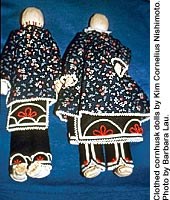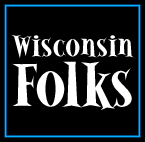|
Home | Search | The Artists | Teaching | Hiring | About This Site | Contact Us |
||
|
Traditions In |
Oneida Corn Husk Dolls
Have you ever been in an art class where everyone had to make something out of a certain material, like wood or paint or paper? Did everyone’s project turn out exactly the same? Probably not. Everybody grows up in different families, lives in different places, has different ideas and likes different things. People’s backgrounds lead them to make very different products even when they use the same materials. Kim’s family has used the same material, corn husks, to make dolls for five generations. Kim still has some of her great-grandma’s, her grandma’s, and her mom’s corn husk dolls. They’re all made from the same material but they all look different! The Dollmakers’ Family Tree
There are many different ways to dress a corn husk doll. Kim’s great-grandma, Amelia made bloomers and slips for her female dolls, just like the ladies wore during Amelia’s time. The clothes she made were unique enough that, as Kim explained, “Even now, if I find a corn husk doll somewhere and it’s made by my great-grandma, I can tell by the style of clothing.” “Budgie,” Kim’s grandma, didn’t make cloth clothes for her corn husk dolls. She dyed the husks Both Kim and her mom, Amelia Cornelius, dress their dolls very much like the first Amelia did. Their dolls wear clothes in the style of long ago, like those of the Oneida who first moved to Wisconsin. Kim also makes dolls with modern clothes, like what Indian people wear today at pow-wows. Bringing it Back
Learn More! If you get the chance, head to the Oneida Nation Museum to see a large collection of corn husk dolls. The museum's website link and links to learn more about Kim's art, her family, and Oneida culture are on Resources for Students. Listen to the Oneida language. Learn about the three other Oneida family clans. Think Lacrosse is only a city in Wisconsin? Find out what Lacrosse means to the Oneida people and how you play it. |
For Educators: |
|
“I think it would have been an art that would have been lost from our people, because only the elderly people knew how to do them.” – Kim Cornelius Nishimoto |
||
|
Home | Search | The Artists | Teaching | Hiring | About This Site | Contact Us |
||


 “We used to go down to my grandma’s and she would have my
mom and my sisters and my sisters-in-law and we’d all get together with some of my aunts and we’d make them [corn husk dolls] all together and we’d see how she made them different than we made
them.” —Kim Cornelius Nishimoto
“We used to go down to my grandma’s and she would have my
mom and my sisters and my sisters-in-law and we’d all get together with some of my aunts and we’d make them [corn husk dolls] all together and we’d see how she made them different than we made
them.” —Kim Cornelius Nishimoto
